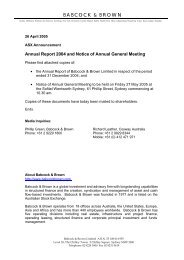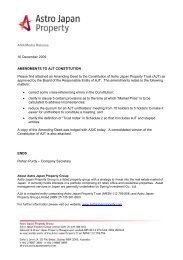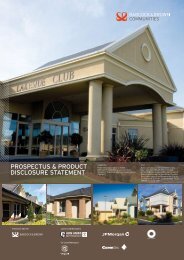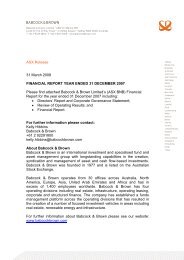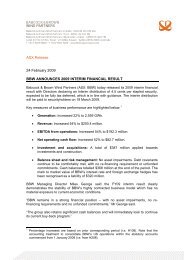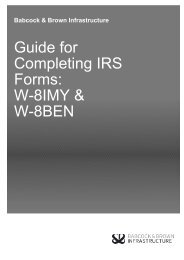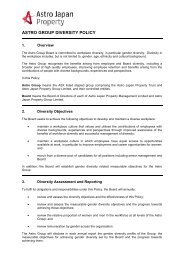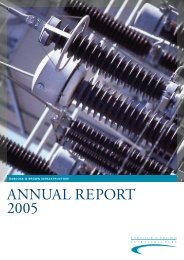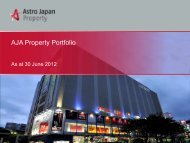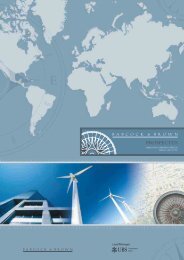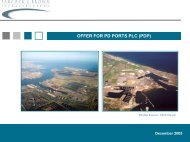BABCOCK & BROWN
bbsn supplementary prospectus.pdf - Astrojapanproperty.com
bbsn supplementary prospectus.pdf - Astrojapanproperty.com
- No tags were found...
Create successful ePaper yourself
Turn your PDF publications into a flip-book with our unique Google optimized e-Paper software.
5. summary financial information<br />
5.7.7 Operating expenses<br />
The operating expenses for the period ended 30 June 2005 of<br />
$99.6 million are 55% of the full year 2005 prospectus forecast.<br />
The increase in the level of total operating expenses for the<br />
period was consistent with the growth of the business during<br />
the period.<br />
5.8 Australian equivalents to International<br />
Financial Reporting Standards<br />
Following the introduction of AIFRS with effect from<br />
1 January 2005, the significant qualitative differences from<br />
AGAAP arising out of application of AIFRS to the Group<br />
were as follows:<br />
• Goodwill — goodwill previously recognised under AGAAP<br />
for the restructure of the Babcock & Brown Group ceased<br />
to be recognised under AIFRS. Amortisation of goodwill<br />
ceased and was replaced by annual impairment testing.<br />
• Share based payments — under AGAAP there is<br />
no requirement to recognise an expense in respect of<br />
share based payments. Under AIFRS, where an equity<br />
instrument is granted to an employee, the value of that<br />
instrument must be determined at the date of the grant<br />
and that value must be expensed on a pro rata basis<br />
between the date of grant and the date the instrument<br />
fully vests with the employee.<br />
• Investment properties — under AGAAP, investment<br />
properties are typically carried at cost or market value<br />
with fair value adjustments reflected through the asset<br />
revaluation reserve. Under AIFRS, changes in the fair<br />
value of investment properties are reflected directly in<br />
the income statement.<br />
• Development properties — under AGAAP, revenue<br />
from the sale of development properties, both residential<br />
and non-residential, was recognised upon exchange of sales<br />
contracts when all conditions precedent have been or are<br />
likely to be met, in accordance with the proportion of the<br />
development completed, provided construction work<br />
in progress was, in accordance with Group policy, more<br />
than 70% complete. Under AIFRS the requirements for<br />
revenue recognition are stricter and hence all conditions<br />
are required to have been met prior to any revenue being<br />
recognised.<br />
• Non-current assets held for sale — AGAAP requires<br />
that all non-current assets with limited useful lives be<br />
depreciated over that useful life. AIFRS provides that<br />
where there is a clear intention to sell a non-current asset<br />
within 12 months and that non-current asset is designated<br />
as held for sale, no further depreciation should be<br />
provided.<br />
• Impairment testing — under AGAAP, the recoverable<br />
amount for all non-current assets carried at cost at each<br />
reporting date is assessed. When the carrying amount of<br />
a non-current asset is greater than its recoverable amount,<br />
the asset is written down to its recoverable amount. Under<br />
AIFRS, assets for which changes in fair value are not<br />
reflected in the income statement will need to be assessed<br />
for indications of impairment on at least an annual basis,<br />
and tested for impairment only when indications of<br />
impairment arise.<br />
• Financial instruments — under AGAAP, it is<br />
permissible to hold certain financial instruments at cost.<br />
Under AIFRS, broadly all financial instruments other than<br />
debt and investments held to maturity must be held at<br />
fair value. Fair value adjustments are made through equity<br />
when the underlying asset has been designated as available<br />
for sale and through the income statement for derivatives,<br />
trading assets and where the reporting entity elects to<br />
reflect the adjustment in this manner.<br />
• Hedging — under AGAAP, where a derivative is held<br />
to hedge a forecast transaction, gains and losses on those<br />
instruments are deferred and brought to account in the<br />
same period as the hedge transactions. Under AIFRS,<br />
derivatives may only be classified as hedges of forecast<br />
transactions where hedge designation, documentation<br />
and effectiveness tests can be met. If these tests are satisfied,<br />
then the hedging derivative is measured at fair value and<br />
gains and losses are reflected directly in equity until the<br />
hedged transaction occurs when they are released to the<br />
income statement.<br />
48 <strong>BABCOCK</strong> & <strong>BROWN</strong> SUBORDINATED NOTES



